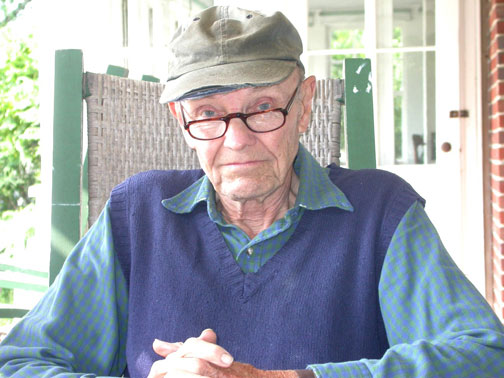
12/11/16. J. Lockwood ("Woody") Chamberlin, 91, passed away at Hill House in Bath, ME after a long illness. He is survived by his children Joe Chamberlin of Snellville, GA, John Chamberlin of Orlando, FL and Ted Chamberlin of North Kingstown, RI, their spouses and three grandchildren. Woody was a long time summer resident of Chebeague Island, where he enjoyed natural history, sailing and spending time with his family.
Woody's son Joe's reminiscence of a time with his father:
He kept adult diving beetles in family Dytiscidae as pets in aquaria. In the wild, diving beetles primarily live in temporary ponds and are scavengers, feeding primarily on insects that land on water surface. He was always looking for a free food source to feed his beetles. He would collect whatever herbivorous insect was abundant (like Japanese beetles), put them in jars and freeze them. When his pet diving beetles were hungry, he would thaw out some bugs and drop them in to the aquaria. My mother was a saint for putting up with jars of frozen bugs in her freezer! When we were kids growing up in D.C. area, dad used to take us on collecting trips where we would catch adult aquatic diving beetles with dip nets. The Lincoln Memorial Reflecting Pool was a favorite spot. As you can imagine, that led to some interesting conversations with tourists and the homeless who wandered by.
Now Chebeague Island assumes center stage in my reminiscence.
One year when we were still living in D.C. (probably early 70s), we caught a larva (immature stage) of one of the larger dytiscids in the genus Cybister. This was my dads favorite diving beetle genus. Unlike adults, dytiscid larvae are strict predators and only eat live food (small fish, tadpoles etc). http://www.mlbs.virginia.edu/organism/predaceousdivingbeetle. So we typically did not keep the larva as pets because it is too much trouble to find live food to feed them. But this larva was almost grown so dad let us keep it to see if we could raise it to adulthood. (Like butterflies, beetles go through a complete metamorphosis. When a dysticid larva decides it is time to become an adult, it climbs out of the pond and pupates in the soil next to the pond. Eventually an adult emerges from the pupa and it reenters the water to mate and continue the cycle of life.) My father put some pond soil at one end of the aquarium with the Cybister beetle larvae and it eventually climbed out of the water and pupated in the soil.
But we had a problem. The beetle pupated right before our annual trip to Chebeague and pupation only last a couple of weeks. And I did not want to miss the adult beetle emerging from the pupa. So my dad put the aquarium with the Cybister pupa in the car and we took it with us to the cottage on Chebeague. And every day, we would check the aquarium to see if the adult had emerged. And one day - there was an adult Cybister beetle! This triggered much excitement in the Chamberlin cottage. The beetle was a female and my father named her Elizabeth, which was the name of his favorite aunt. Elizabeth returned with us to D.C. and lived another couple of years, happily feeding on whatever frozen bugs my father dropped in her aquarium.